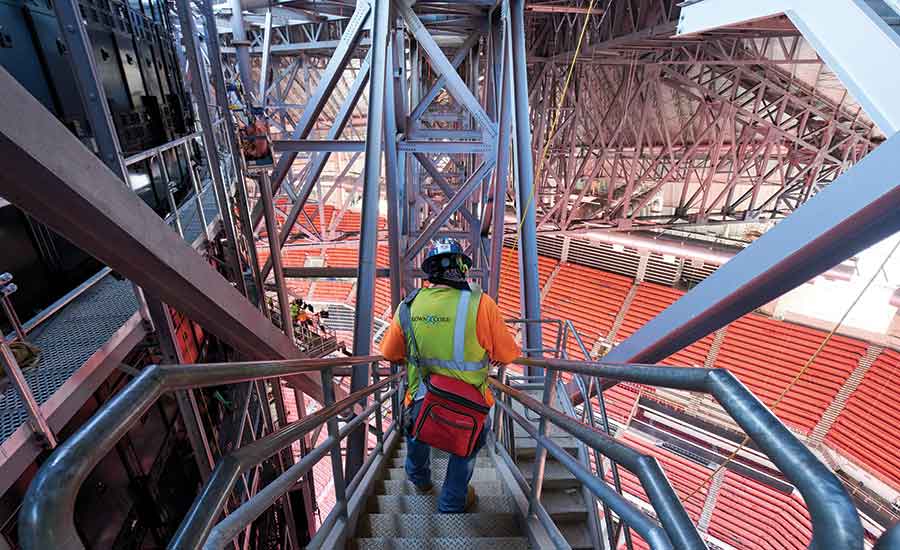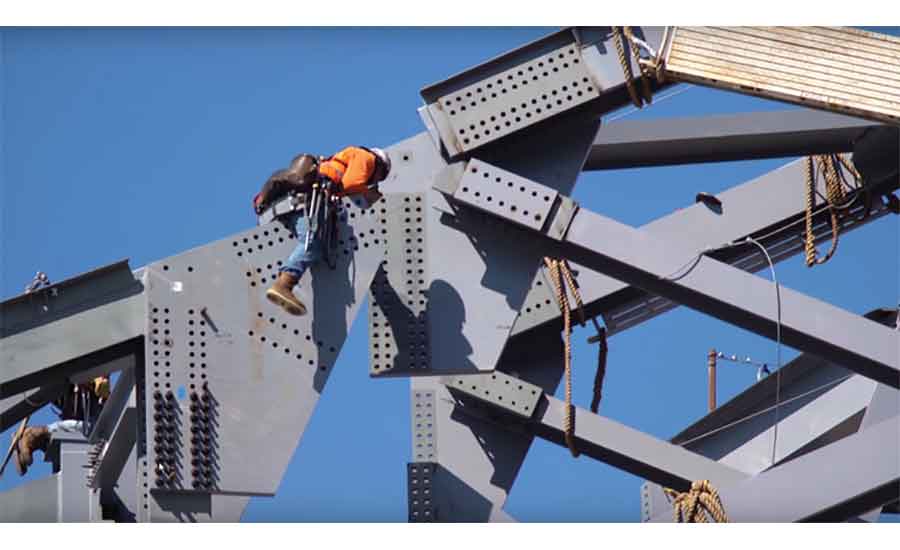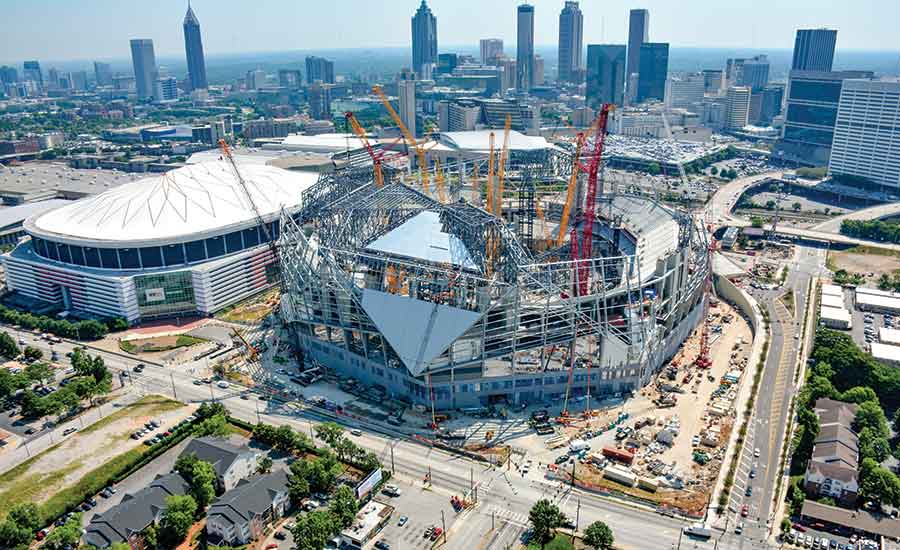Sports Construction
The Agonies of Building Atlanta's Mercedes-Benz Stadium
And the exhilaration of creating the 'most complex roof' ever

The multipurpose stadium has a cavernous interior
PHOTO: HALES PHOTOS

Kinetic petals
PHOTO: HALES PHOTOS

A segmented oval hole in the fixed roof
PHOTO: HALES PHOTOS

Shown during petal erection
PHOTO: EARTHCAM

An edgy asymmetrical form
PHOTO: HALES PHOTOS

Steel connections that dwarf the humans building them.
PHOTO: MERCEDES-BENZ STADIUM

The steel erector used sixteen 200-fttall falsework towers to erect—in 99 crane picks— one of the longestspanning two-way truss systems in the world.
PHOTO BY JONATHAN TRIBO

Workers hung sections of the halo bracket onto a primary truss section that workers assembled on the ground.
PHOTO BY JONATHAN TRIBO

The world’s biggest crawler crane lifted the longest and heaviest pick, a 220-ft-long truss section that weighs 800 tons.
PHOTO BY JONATHAN TRIBO

The eight cantilevered petals of the stadium’s kinetic cap, which look like pie slices (drawing 1), slide open on the diagonal (drawings 2 and 3), while they give the illusion of spinning. Roof-cap petals open onto the 70-ft-deep trusses of the flat, fixed roof—an eight-pointed star in plan—in less than 10 minutes (drawing 4) .
GRAPHICS COURTESY BUROHAPPOLD

The eight cantilevered petals of the stadium’s kinetic cap, which look like pie slices (drawing 1), slide open on the diagonal (drawings 2 and 3), while they give the illusion of spinning. Roof-cap petals open onto the 70-ft-deep trusses of the flat, fixed roof—an eight-pointed star in plan—in less than 10 minutes (drawing 4) .
GRAPHICS COURTESY BUROHAPPOLD

Nodes at truss intersections contain as many as 15 members coming in at many different angles. Rotating 3D-model views helped with shop-drawing approvals.
PHOTO BY JONATHAN TRIBO

The roof of the stadium contains 27,500 tons of steel. The flat, fixed roof has 17,000 tons, much of it in a two-way truss system that is 70 ft deep and spans as much as 723 ft. Kinetic petals of the upper roof weigh 3,200 tons. The nonorthogonal layout of the longspan trusses—determined by the roof’s oval opening— complicated structural analysis, fabrication and erection.
GRAPHIC COURTESY BUROHAPPOLD

Crawler cranes crowd the field during the erection of the long-span trusses (above) and the petals (next image) at the site, adjacent to the Georgia Dome.
PHOTO: AERIAL INNOVATIONS/HHRM

Crawler cranes crowd the field during the erection of the long-span trusses (prevous image) and the petals (above) at the site, adjacent to the Georgia Dome
PHOTO: HALES PHOTO

One-of-a-kind video scoreboard, an ellipse with a 1,075-ft circumference, contains 37 million LEDs.
PHOTO COURTESY DAKTRONICS
















Just about every Tuesday for three years, structural-engineer Erleen Hatfield arose at 3:30 a.m. to catch a 6 a.m. flight from New York City to Atlanta. The early riser was determined to make a 9:30 a.m. meeting for her most dynamic project in more than a quarter century of practice—a 2-million-sq-ft stadium with a 14.5-acre convertible roof that opens and closes at its center, much like a camera lens iris. The daring design, which brazenly departs from kinetic-roof sports architecture, makes earlier “boxes with sliding lids” look almost simple.
During the plane’s descent—and especially since last year when the 27,500 tons of roof steel started taking shape—Hatfield received her reward for the sleep deprivation: a birds-eye view of the imposing facility, which is 305 ft tall. “Seeing the progress from the air was amazing and exciting,” says Hatfield, a principal of BuroHappold Engineering (BH), structural engineer for Mercedes-Benz Stadium, formerly called the New Atlanta Stadium.
The steel-framed roof, with its grand spans, long cantilevers, skewed connections and dynamic deflections, has been the most frustrating.
The demanding $1.5-billion project, nearly complete but delayed and over budget, has exhilarated, fatigued and tested the mettle of its building team—Hatfield included. One contractor likens its experience to a runner who ends the race limping—crawling maybe—across the finish line.
The steel-framed roof, with its grand spans, long cantilevers, skewed connections and dynamic deflections, has been the most frustrating. “This is a one-of-a-kind building,” says Wayne Wadsworth, principal-in-charge for the general contractor, the Holder-Hunt-Russell-Moody Joint Venture (HHRM). “It is probably the most complex roof ever built—fixed or operable.”
The asymmetrical stadium’s main roof, which supports the operable cap, weighs 17,000 tons, is 70 ft deep, spans up to 723 ft and contains 850,000 bolts. It is framed by one of the world’s longest-spanning two-way truss systems.
The roof opening is a segmented oval, not a circle, to better reflect the field below. The shape resulted in a nonorthogonal layout of the fixed trusses, which complicated structural analysis, connection detailing, fabrication and erection.
The oval also made the roof’s operable section, which weighs 3,200 tons, more difficult in every way. In a visual sleight of hand, the kinetic cap—formed by four pairs of dimensionally different elements, called petals—appears to spin apart as it opens. In reality, the trussed petals move apart on the diagonal in a carefully synchronized slide. In the closed position, the triangulated petals, which cantilever 156 ft to 196 ft from heel to tip, resemble skewed pie slices.
When the petals move, the fixed roof deflects 5 in. So does the 850-ton elliptical video scoreboard system—another sports-venue first. The 360˚ “halo” display, which hangs from the fixed roof under the oval, is 57.7 ft in its vertical dimension and 1,075 ft in circumference. It contains 37 million light-emitting diodes (LEDs).
Article Index
- Missed Milestones
- Dark Horse
- Consensus
- Brainchild
- Strategy Switch
- Problem Avoided
- Ductwork Savings
- Time-Lapse Video
Missed Milestones
The job’s complexities caused some missed milestones. “There is no question that building a stadium as unique and forward-thinking as Mercedes-Benz Stadium comes with challenges, but we haven’t backed down,” says Arthur M. Blank, chairman-owner of the stadium’s developer-operator AMB Group LLC, which also owns the National Football League’s (NFL) Atlanta Falcons and Major League Soccer’s Atlanta United FC.
AMB is responsible for all development costs other than $200 million from bonds issued by Invest Atlanta that are secured by hotel-motel tax proceeds.
Costs ballooned $300 million from the $1.2-billion price AMB announced in 2013 and roughly $400 million from the guaranteed maximum price of nearly $1.1 billion agreed upon in November 2014 in HHRM’s GMP contract. That contract set HHRM’s substantial completion date as March 31, 2017. Completion was set for July 29.
In January, AMB pushed the March date to June 1. In April, AMB said the stadium would open on Aug. 26, in time for a Falcons preseason game against the Arizona Cardinals. In late July, AMB announced that the kinetic portion of the roof would be in the closed position when the stadium opens and would remain that way until some time this fall, after work is finished to fully automate the operable portion.
Considering all the challenges, “We are very pleased to be opening when we are opening,” says Mike Egan, AMB’s senior vice president and general counsel.
AMB says the fixed-roof steel triggered the delays. “Completion of the final design development and construction documents for the steel construction took longer than initially expected,” says AMB, in a statement to ENR. “All of the major elements of the steel construction schedule were dependent on the completion of the fixed roof and thus impacted when the schedule shifted.”
Hatfield says BH issued “a comprehensive and complete” set of structural design drawings a few days ahead of its Dec. 1, 2014, deadline. “We issued the 65-ksi steel mill order and the 50-ksi mill order before the contract documents,” she adds. And BH says it issued connection design drawings from August 2014 through January 2015.
Steel contractor Canam Group Inc. declined to comment. In an email, François Bégin, vice president of communications, says Canam does not want visibility on the stadium job, “given that we announced last February our decision to no longer act as a structural steel contractor for complex and large‑scale projects, such as the MBS.”
Dark Horse
In 2013, as a senior principal of 360 Architecture, Bill Johnson shook up the sports-construction world, when, as the dark horse, 360 won the project (ENR 7/14-21/14 p. 42). “I went in knowing this would be a game-changer and a really difficult project, but I never had any doubt it would be achieved,” says Johnson, a design principal with stadium architect HOK, which acquired 360 in 2015. “Maybe I overestimated what people knew,” he adds.
“No one understood the complexity,” not even the designers, says William E. Darden Jr., president of Darden & Co., AMB’s project manager. “That’s a shame because I think Arthur was owed” that explanation.
The 71,000-seat multipurpose venue sits on state land that abuts the 25-year-old Georgia Dome stadium—set to be razed on Nov. 20. The Atlanta Falcons Stadium Co., controlled by AMB, holds design and construction contracts and licenses the right to manage and operate the facility from the state owner, the Georgia World Congress Center Authority. GWCCA approved the design team and provides project oversight.
“The Falcons stepped up and created an iconic facility that exceeds expectations,” says Frank Poe, GWCCA’s executive director.
Even the artwork is iconic, as evidenced by the 66-ft-wide, 43-ft-tall stainless-steel sculpture of a falcon grabbing a football in front of the entrance plaza. The striking piece is the largest freestanding bird sculpture in the world, according to the artist, Gabor Miklos Szoke.
Consensus
Team frustrations aside, Blank’s perseverance is appreciated. “When a building goes from $1 billion to $1.5 billion and we don’t flinch when it comes to compromising the fan experience, that’s a real commitment,” says Scott Jenkins, stadium general manager.
“The roof could have gone away, but it didn’t,” he adds. The same goes for the LEED-Platinum green-building certification—a stadium first. And the halo or the window with skyline views—300 ft wide and more than 200 ft tall—could have been smaller.
Darden adds, “Arthur could have said, ‘Stop the presses.’” Instead, to get the roof done, “We locked arms, pulled together, and figured it out as a team,” he says.
The angular six-level facility, equivalent in height to a 25-story high-rise, has three main roof elevations. The lowest consists of sloped-and-bent, downward-pointing triangular metal panels that morph into facade panels, alternating with triangular window walls.
The flat, fixed roof—with its roughly 385-ft x 310-ft hole—is the second elevation. Primary, secondary and backspan trusses intersect to create a “racked” crisscross pattern, in plan.
Trusses are fixed at one end and slide on bearings on the other to accommodate changing temperature and wind loads and petal movement. The spans bear at their ends on 19 reinforced concrete megacolumns, each 179 ft tall and up to 28 ft x 13 ft, in plan. Megacolumns are located along the seating bowl’s outer perimeter.
The weight of the fixed roof increased from original estimates primarily because halo weight doubled and 600,000 sq ft of flat roof cover went from a 0.5-psf material to 5-psf metal deck, according to BH.
The changes added 800 tons of steel. With each change, BH re-analyzed the roof.
For connection design, BH followed the American Institute of Steel Construction’s Code of Standard Practice. Two subconsultants, Ferrell Engineering and MBJ Engineers, assisted BH. Canam designed some of the simpler connections.
The roof’s cap is formed by the petals, which come in four sizes, thanks to the oval opening. In the closed roof position, twin petals are diagonally opposite each other.
Each petal is framed along its length by three main trusses, which taper from 30 ft deep at the heel to 4 ft deep at the tip. The trusses shape the slope of the cap.
Petals are from 196 ft to 232 ft long and 128 ft to 160 ft at their widest. When closed, they overlap the primaries by 40 ft, at the heels.
Each petal rides on the diagonal on parallel rail girders, located 40 ft apart on the fixed roof. The cantilevers put a downward force on inner rail girders and an upward force on the outer ones, which are supported by backspan trusses that span from a primary truss to a megacolumn.
Each petal bears on eight two-wheel bogies along its inner rail. Uplift on the outer rail is resisted by six roller assemblies. Again, thanks to the oval cap, adjacent petals—with different dimensions—travel at different speeds on different-length rails, from 225 to 375 ft. Maximum speed is 30 ft per minute. The system opens or closes in under 10 minutes.
The technical challenges of the design of the travel equipment are on par with its other six operable-roof stadiums, says Mark Silvera, president of travel mechanization consultant-supplier Uni-Systems Engineering. But “this stadium is a bigger challenge” than others because of its controls system, which must coordinate eight panels successfully to complete a move, Rivera adds.
Brainchild
The elliptical halo is the brainchild of HOK’s Johnson. “It has the potential to transform the modern game-day broadcast,” with its panorama of information and activity, says the architect.
The 62,028-sq-ft display board, which weighs nearly 372 tons, is three times larger than the next largest LED video display in the NFL, says the supplier, Daktronics.
“Many iconic displays are large with simple geometry or small with complex geometry,” says Kyle Maurer, mechanical design engineer for Daktronics. “This display has unprecedented location, size and geometry.”
The halo’s pure ellipse is generated by small angular differences, from 0.3˚ to 0.5˚, between the flat display facets. To settle on a shape, Daktronics and HOK structural engineers adjusted the ellipse’s radii and the elevation off the field, to avoid interfering with sightlines.
The display’s steel-bracket backing has a header truss and framing for five levels of service-access catwalks. The halo accounts for 5.2% of the fixed-roof weight, says BH.
The brackets were designed to allow for vertical and in-and-out adjustments from the face of the video board, both during construction and petal movement, says Ben Elsasser, Daktronics’ structural engineer for the display.
The halo is 100% operational but stadium construction, which started in March 2014, is only 98.5% complete. Work was finished on the foundations, the megacolumns and the seating bowl by the end of 2015.
Time-Lapse Video: 39 Seconds to a Nearly Finished Stadium
For the roof steel, Canam subcontracted connection detailing to about a half-dozen shops. “It was challenging to work with [so many] different detailers” but Canam tried to make the details consistent, says BH’s Hatfield.
BH reviewed 50,000 shop drawings almost exclusively in 3D. “Being able to spin these was a huge benefit for us,” says Hatfield. Many truss-intersection nodes had as many as 15 members, at various skewed angles, coming into them. The norm is four to six.
Shop-drawing approval took a year, ending in January 2016. BH’s turnaround time for a drawing’s approval averaged 7.8 days, says Hatfield. The contract allowed two weeks.
Strategy Switch
According to HHRM’s Wadsworth, when the schedule slipped, Canam switched its strategy to split fabrication of the 27,500 tons of structural steel from “a half-dozen plants for structural steel only,” or 10 total counting joists, deck, painting and such, to “close to three dozen” total in North America.
This was done to accelerate the schedule. “A normal schedule would not have delivered the stadium on time,” Wadsworth says.
The switch caused logistical and delivery complications, which had an impact on the erection sequence. HHRM, Canam and steel erector Derr & Isbell Construction devised “the best logical order” possible for steel delivery, based on each plant’s capacity and capability, among other factors, says Wadsworth. To accommodate the switch to so many fabricators, “we had to move raw steel from one fabricator to another three or four times,” he adds.
Canam formed two roving crews to laser-scan the assemblies at the various plants. Then, Canam superimposed the scans on the structure’s 3D model.
“If things didn’t line up, they were fixed in the plant before the steel left,” says Wadsworth. It would have been “catastrophic” for the schedule if, during erection, any of the truss-intersection nodes had been off, because the trusses would have had to come down, he adds.
Local ironworkers, and crews brought in from many places around the U.S., began fixed-roof steel erection in March 2016 and finished up last November, including the jacking down of the cambered roof. The system came down 23 in., within the anticipated range.
Derr & Isbell, which was not available for comment, erected the main trusses in 99 picks. The heaviest was 800 tons and 220 ft long. Six picks weighed over 500 tons; 21 over 300 tons and 52 over 100 tons.
Crews used a staging yard seven miles away for some preassembly work, including the top-chord boxes. Trucks moved truss pieces onto the field area through an opening left in the bowl. The erector had created a jig inside the bowl and also installed sixteen 200-ft-tall falsework towers under the skewed truss intersections. There were four megashores under the intersections of the four primary trusses and 12 smaller towers at all the other intersections.
The strategy was to treat the eight-way truss system, at least initially, as if it were a typical box-with-a-lid, by first erecting parallel primary trusses on opposite sides of the field, says HHRM.
Crews began on the northwest side by lifting a section of one primary truss and setting it between its megacolumn and its megatower. After the entire primary truss was set, crews did infill picks, which also included sections of the other two intersecting primary trusses. Then, crews moved to the southeast side of the stadium and repeated the exercise for that primary truss.
Initially, for the trusses, the steel erector used two 1,250-ton-capacity crawler cranes and one 600-ton crawler. In the spring of last year, the erector accelerated the schedule by using a 2,500-ton Manitowac crawler crane—one of only two of its size in the world. Crews were eventually working all over the site, day and night, seven days a week.
Problem Avoided
A potential fit-up problem was avoided, thanks to a ground survey of a 200-ft-long midsection of a primary truss and the measurement of its “slot” between two end sections already erected. The midsection was too long to fit, says HHRM. The solution was to ice the steel of the midsection to contract it and to erect it at night, when it was cooler.
The roof steel received nonconformance notices, but they were “in line with a job of this size and complexity,” says Bob Evans, HHRM’s general superintendent. All the NCNs will be resolved, mostly by field welding, by the time of occupancy, he says.
Crews installed the halo bracket, made of 24 segments around the ellipse, concurrently with the primaries and before the roof deflected during the jacking-down operation. Workers piggybacked some bracket segments on primary truss sections and picked them as a unit. Others were picked alone and hung from the erected primaries.
Rail girders had been erected with the fixed-roof trusses. Once the roof was decentered, workers aligned rails that were not within the specified tolerance of about 1⁄8 in. over 70 ft.
Petal erection started last January and ended on May 5. The travel mechanism installation overlapped from February through April.
Crews installed petals in four sections. First, cranes picked all eight heels—with bogies and uplift roller assemblies—in their closed position by moving around the opening. Using the same strategy, they then erected the cantilevered midsections of the petals.
At that point, there was no elbow room left in the center of the opening to install the petal tips and the “button” that joins them. On April 21, to make crane-boom room, the first construction move took place to open the petals.
A fourth move took place on July 25. It was planned as the final construction move, but another is required that will take place in a few weeks, says AMB.
The automation-mechanization process, which takes roughly 40 work days, can’t begin until the final construction move is complete. After the stadium opens, work will be done around events to complete the operable system, says AMB.
Beyond rail alignment, the biggest adjustment was the shimming of the petals to balance the loads that go through the bogies and uplift rollers. Loads have to be evenly distributed for the system to work properly.
The load balancing required more shimming than expected. During the procedure, the steel erector used temporary steel diagonals to brace the petals against the fixed structure. The disconnected braces remain for use in the future, if they are needed.
Petals are covered by about 135,000 sq ft of inflated “cushions” of ETFE, a lightweight plastic that has high corrosion resistance and strength over a wide temperature range. This is the first use of ETFE on an operable portion of a stadium roof, says Bird Air Inc., the supplier of the roof covering.
Cushions consist of four layers of translucent ETFE configured in two chambers. Fritted on the surface, the cushions behave like insulated windows, helping to control environmental variables.
If pressure gauges sense the need for more air to resist temporary loads, such as wind or snow, blowers pump in more air. Each blower unit has a backup blower, in case the primary blower fails.
There is also 165,000 sq ft of vertical transparent ETFE on the facade, which was completed in January. Only the picture window with the view of the skyline is without frits. Bird Air used rope access technicians to install the window, because it is taller than the 185-ft reach of the personnel lift, says Michael Sparks, Bird Air’s vice president of construction.
Bird Air also used rope access technicians for the petal cushion installation, which is complete.
Ductwork Savings
Though the essence of the original design remains, some details have changed. One redesign, early on, saved 500 tons of ductwork and $8 million in labor and materials, says Chris Skoug, principal engineer for the design-build mechanical contractor, Atlanta Stadium Partners Joint Venture, which includes Southland Industries, TD Industries and ARS Mechanical.
Instead of 90-in.-dia ductwork hanging from the crisscross of main trusses, the layout consists of two concentric rings of 60-in.-dia ductwork—one on either side of the blackout curtain that isolates the upper-bowl seating. 3D airflow analysis validated the redesign.
Though over budget, the development may very well be a financial success. In 2015, Mercedes-Benz bought the naming rights for an undisclosed sum under a 27-year agreement. AMB has announced nearly $1 billion in sponsorships. And the Falcons have sold more than 48,000 personal seat licenses, worth $233 million.
Recently, Arthur Blank has been walking the site every week and getting daily progress briefings. “I am grateful for all that Atlanta has given me,” says the 74-year-old native New Yorker, who relocated to Atlanta nearly 40 years ago to open the first Home Depot hardware-and-home-improvement store. He adds, “We built Mercedes-Benz Stadium to say thank you to our fans, to our city and to the communities and neighbors we serve.”
Editor's Note: This article was updated on Aug. 1, to reflect the latest project news.





















